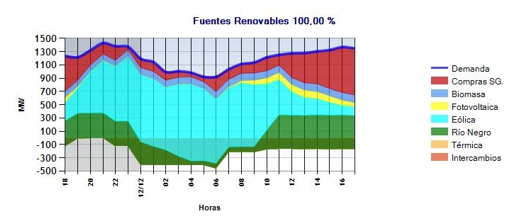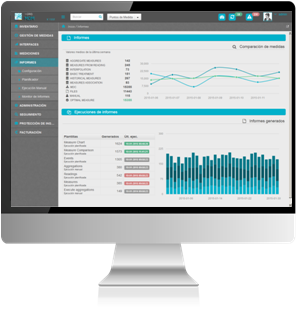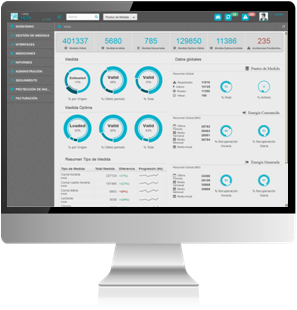The Energy sector in Uruguay
Since 2010, a major investment in energy has been unfolding in Uruguay, which has arisen through close collaboration between the private sector and the Government. This collaboration places Uruguay in the regional forefront in renewable energies. With a 62% stake in such energies, there is a significant reduction of the dependence on conventional energy sources within the energy matrix.
This change in the energy matrix translates into a major step toward decarbonization, increasingly reducing its dependence on energy sources based on polluting fossil fuels.

In this way, the Government is enforcing the guidelines established by a policy that is firmly committed to renewable energies, with significant short-term goals and attractive tax privileges that contribute to the development of the sector. All of this is related to a technological transition in which it is necessary to implement new mechanisms for the control, process and better manage the information generated by these new energy sources.
UTE (Administración de Usinas y Transmisiones Eléctricas) is the State company in Uruguay tasked with generating, transmitting, distributing and marketing electricity throughout Uruguay and, therefore, responsible for taking on these technological challenges.
UTE currently serves approximately one million and a half customers throughout Uruguay, with an installed capacity of around 8,500 GWh through hydraulic, wind, photovoltaic and thermal (biomass and fossil fuel) power plants. Over 98% of the electricity generated in Uruguay in 2017 has come from renewable sources.
UTE is projected as a State-owned company recognized for the excellence of its service, as well as for being dynamic and open to energy integration and to the development of related business, standing as a benchmark for the rest of Latin America
InGRID MDM implementation in UTE
Within this context of energy evolution, UTE is to undertake a series of projects as part of the Smart Grids Master Plan, in which the implementation of MDM (Meter Data Management) is the cornerstone for all other activities focused on energy efficiency, distributed generation and progressive elimination of power generation from polluting sources. This task was awarded to Indra and thereby set a close commitment between the two companies.
UTE and Indra work together in this project for the development, configuration, implementation and commissioning of a Meter Data Management System based on Indra's InGRID MDM (Meter Data Management) proprietary product as well as integration with the Uruguayan electricity company's commercial management and distribution systems.
As Eduardo Bergerie, Director of the Smart Grids Project in UTE said, “Indra’s contribution has enabled us to speed up our developments in order to introduce a tariff model focused on energy efficiency. In the near future, tariffs will be customized according to our customers’ needs”.
Indra's InGRID MDM product is designed to support smart metering management at Industrial, Commercial and Residential level, allowing the two-way management of large volumes of information. It considers such advanced functions as:
- Energy balances
- Real time analysis of information
- Analysis and management of demand
- Consumption estimates based on historical, weather and seasonal data
- Fraud management
- Management of setpoint values with the grid operator and the end customer
- • As a key differentiating element, it enables the profiling of hourly curves based on end customer consumption (typically, monthly) which, in the near future, will enable customers to be billed based on the price at each time period (peak, shoulder and off-peak).


Its purpose is to modernize and optimize meter management, whether AMI (Automated Metering Infrastructure) smart meters or conventional meters, and their associated processes: precision in the calculation of electricity consumption and load curves at the measuring points, generation of bills for customers based on actual consumption, a reduction in energy losses and, in general, the processes of analysis, diagnosis and optimization of networks for distributing energy and the quality of the service provided. This technology shall enable the customer to develop opportunities for proposing smart rates and added-value services. All of this is possible thanks to the implementation of Big Data technology, based on an HBase repository controlled by the entire Cloudera Stack. It is important to note that InGRID MDM is certified by the Cloudera suite, thereby ensuring its correct operation on Big Data technologies and the security of this sensitive information in a Big Data repository.
Implementation of the InGRID MDM product in UTE is considered essential for the launch of future service proposals for its customers, as it is the basis for automating customer billing based on dynamic rates or discounts based on different consumption plans, allowing the generation of, among others, commercial packages personalized to each customer type, or generation of the so-called opportunity-based proposals.
Access to energy and voltage load curves will enable analysis of consumption habits and assessment of the quality of service provided by UTE. It also aids the early detection of any irregularities in customers that contributes to the reduction of losses, and possible cases of fraud.


The system, which is already in production, will support efficient management for all smart meters and other devices installed in the future by UTE (approximately 750,000 smart meters and 800,000 conventional meters), and is available for approximately 300 concurrent users.
As regards the next steps, the roll-out of Smart Meters will begin in 2018, until the target number of meters, using the InGRID MDM product as a repository of information, analysis and exploitation of all the data generated by these smart devices.
Fuentes: Sources: UTE, Uruguay Siglo XXI